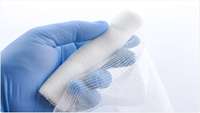Cellulose wound dressing uses peptides to kill bacteria
Although it's vitally important to keep wounds free of harmful bacteria, antibacterial ointments have to be regularly reapplied, requiring bandages to be removed. A new wound dressing, however, is claimed to continuously kill bacteria all on its own.
Activation of TRPA1 nociceptor promotes systemic adult mammalian skin regeneration
Adult mammalian wounds, with rare exception, heal with fibrotic scars that severely disrupt tissue architecture and function. Regenerative medicine seeks methods to avoid scar formation and restore the original tissue structures.
Silk scaffolds and magnetism to generate bone tissue and be able to use it in implants
The journal Materialia has recently published the outcome of a piece of research conducted by a group of researchers comprising several from the Department of Physical Chemistry at the UPV-EHU's Faculty of Science and Technology and BCMaterials, and others from centres at the University of Minho (Portugal).
Next-Gen Organoids Grow and Function Like Real Tissues
Organoids are fast-becoming one of the most cutting-edge tools of modern life sciences. The idea is to use stem cells to build miniature tissues and organs that accurately resemble and behave like their real counterparts.
Nobel Prize in Chemistry Awarded to 2 Scientists for Work on Genome Editing
Emmanuelle Charpentier and Jennifer A. Doudna developed the Crispr tool, which can alter the DNA of animals, plants and microorganisms with high precision.
Researchers develop new mouse model for SARS-CoV-2
Animal models that recapitulate SARS-CoV-2 infection and disease are urgently needed to help researchers understand the virus, develop therapies, and identify potential vaccine candidates.
Getting gene therapy to the brain
lone genetic mutation can cause a life-changing disorder with effects on multiple body systems. Lysosomal storage diseases, for example, of which there are dozens, arise due to single mutations that affect production of critical enzymes required to metabolize large molecules in cells. These disorders affect multiple organs including, notably, the brain, causing intellectual disability of varying degrees.
The heat is on for building 3-D artificial organ tissues
Bioengineers are devising a hot new technology to remotely control the positioning and timing of cell functions to build 3-dimensional, artificial, living tissues.
Computational gene study suggests new pathway for COVID-19 inflammatory response
Analyses of lung fluid cells from COVID-19 patients conducted on the nation’s fastest supercomputer point to gene expression patterns that may explain the runaway symptoms produced by the body’s response to SARS-CoV-2.











